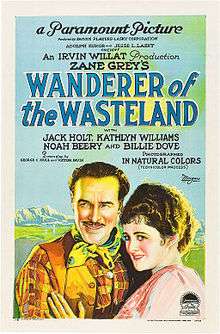Wanderer of the Wasteland (1924 film)
| Wanderer of the Wasteland | |
|---|---|
 Theatrical release poster, likenesses of Jack Holt and Billie Dove | |
| Directed by | Irvin Willat |
| Produced by | Lucien Hubbard |
| Written by |
|
| Based on |
Wanderer of the Wasteland by Zane Grey |
| Starring | |
| Cinematography | Arthur Ball |
Production company | |
| Distributed by | Paramount Pictures |
Release dates |
|
Running time | 60 minutes |
| Country | United States |
| Language |
Silent English intertitles |
Wanderer of the Wasteland is a 1924 American color silent Western film directed by Irvin Willat and starring Jack Holt, Noah Beery, and Billie Dove. This was the third feature film to be photographed entirely in Technicolor.
Plot
The film is based on Zane Grey's 1923 novel of two brothers, one an honest cowpoke, the other a gambler. When Adam Larey (Jack Holt) confronts his younger brother Guerd (James Mason) about his gambling addiction, the latter is accidentally shot. A distraught Adam, believing he has killed his own brother, flees into the desert. He later learns that Guerd was merely wounded and returns to the loving arms of beautiful Billie Dove.
Production background
Paramount Pictures decided to make a picture entirely in Technicolor following the success of the Technicolor sequences in the film The Ten Commandments (1923) and director Irvin Willat's own Heritage of the Desert (1924).[1]
Preservation status
The film is now considered to be a lost film. An original cemented Technicolor print survived into the 1960s in the hands of the film's director, Irvin Willat, who reported in 1971 that the 35 mm nitrate film had decomposed and turned into jelly.
After Willat's death, his daughter mentioned that she remembered the day when he discovered that Wanderer of the Wasteland had decomposed. She said he went upstairs to his bedroom, closed the door and cried for three hours. His former wife Billie Dove starred in the picture, and he had never really come to terms with their separation. Dove was lured away from Willat by Howard Hughes, who essentially purchased her away from him.
References
- ↑ Los Angeles Times, January 23, 1924.
External links
- Wanderer of the Wasteland at the Internet Movie Database
- Wanderer of the Wasteland at Silentera.com
- lobby poster; Wanderer of the Wasteland(flickr)